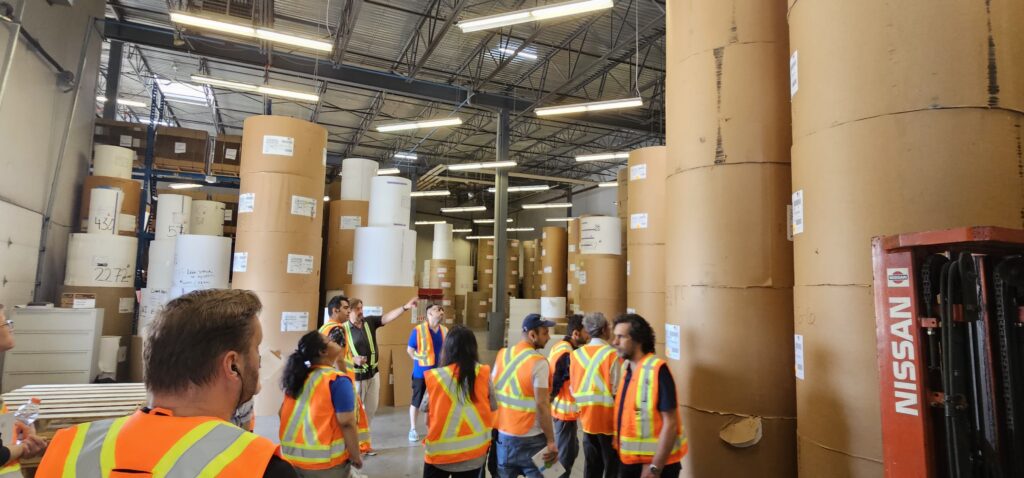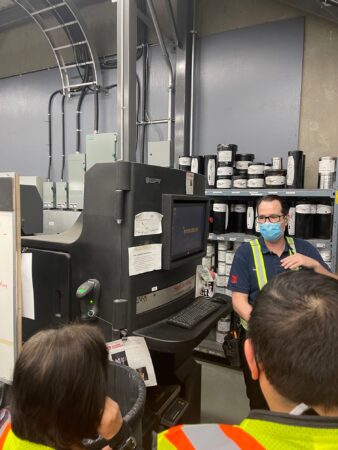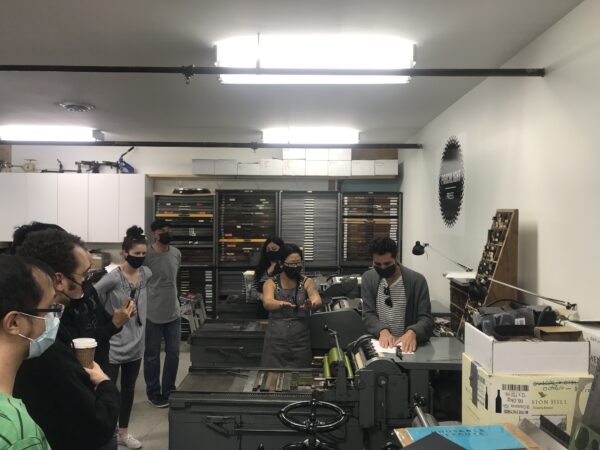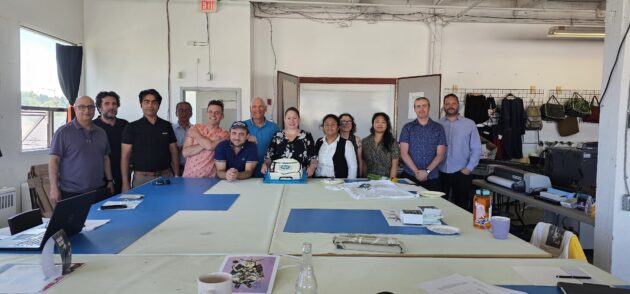
Features
Training
Real answers, real training
A look at the innovative PELT program of B.C., which has a success rate that begs for national adoption
April 8, 2024 By Treena Hein
 PELT students on a guided tour of Mitchell Press, Burnaby, B.C. Photos © PELT
PELT students on a guided tour of Mitchell Press, Burnaby, B.C. Photos © PELT Practical, useful, truthful, eye-opening – those are just a few ways that graduates of the B.C.-based PELT (Print Entry Level Training) describe the program. Take Gerald Rath, who took the free 10-week program in mid-2023 and is now a production operator at Hemlock Harling in Richmond. He reports that while he enjoyed the basic overview of the print industry through “studying the excellent textbook and lectures, I relished being able to talk to seasoned professionals.”
Rath describes these professionals (who gave tours of their operations to PELT participants) as “very honest” about their businesses and the future of the printing industry as well. He reports that he and his fellow students asked many tough questions about starting pay, highest possible eventual pay, whether there are typically layoffs during slow times of year, and much more, and he says all questions “were answered honestly and succinctly, so as to not give students an unrealistic view.”
Another PELT graduate, Hossein Hosseinian, explains PELT confirmed for him that a career in the print industry would be an exciting opportunity for him to put his cabinet-making experience to good use. “As I learned more about printing, I saw it matched my skills,” says Hosseinian, who is now working in production at Great Little Box Company, also in Richmond. “It felt like a good change for me. I learned about different materials and how to design.”
PELT, now entering its fourth year, is offered through PrintForward Printing and Imaging Association of B.C. and its Next Generation Task Force. Funding is provided by the federal government through the Canada-B.C. Workforce Development Agreement, under the Ministry of Post Secondary Education and Future Skills through the Community Workforce Response Training Grants. PELT is delivered by the NorthWest Skills Institute (NWSI), which offers a wide range of vocational certificate programs and health and safety training.

PELT covers all aspects of the industry from the history of print, production processes, bindery, printing presses, and prepress skills to job readiness.
With over 40 graduates and a job placement rate of 85 per cent, PELT continues to be a highly successful way of easing recruitment pressures and bringing new vitality to B.C.’s print industry. According to PELT program director Jennifer McConnell (who’s also director of operations at Royal Printers in New Westminster, B.C.), the program model has the potential to be replicated across Canada.
This model, a free, honest, and jam-packed introduction to the sector, requires participants to apply for full-time print industry jobs at graduation. It also provides job application training and assistance with job application submission. Rath explains that “revising my resume, coaching me on how to ace job interviews and even how to act after being hired (e.g. attend all social events held by the employer; don’t be anti-social), was all invaluable information. I credit this to NWSI having direct contact with those employed in the printing industry for several decades. NWSI did not just give general advice.”
Rath also very much appreciated that he didn’t have to demonstrate the reasons why he was seeking job retraining in order to be accepted to PELT. Incidentally, Rath’s reason for taking PELT was to try something new, and because, as an experienced graphic designer and operator in the sign industry, he was frustrated. “No matter the position for which I was hired over the past few years, I was soon transferred to installation,” he says. “This is because most sign installers have long since left for the far more lucrative careers in the construction industry.”
Hosseinian was looking for a new career where he could apply existing skills and thought PELT looked interesting. Some students like Rath are also able to access financial support through WorkBC, free transit passes and more.

Weekly tours to local printing companies exposed PELT students to different print environments and how they can apply their skills in the corporate world.
Rath strongly valued the help with job applications, which led to him being employed very soon after PELT completion. “I very much appreciated that the NWSI applied for several jobs within the local printing industry on my behalf,” he says. “These jobs were based on my past work experience, and on in-class cleanliness, attendance, punctuality, and comprehension of class material. Thus, the potential employer was getting the real picture of my capabilities, while I felt confident the potential employer was not a flash in the pan or only interested in hiring temporary employees for the busiest season.”
Sector needs
NWSI senior program manager Cormac O’Reilly applauds the Next Generation Task Force and PrintForward team for leading the charge with this program in order to address the looming print industry labour shortage. “As part of curriculum development, the NWSI team visited and spoke with a number of PrintForward employer members to understand their needs, and the skills required for a person to start work within this sector,” he says.
From “this invaluable insight and input,” PELT was born. It covers all aspects of the industry right from the history of print, print production processes and planning, bindery, printing presses, creative suite prepress skills, packaging and mail, safety, Kaizen, and as mentioned, job readiness. Guest speakers are an important aspect of PELT, along with weekly tours to local printing companies that expose students to different print environments and how their training would be applied in real-life situations. “The tours were also a great way to help students see what type of printing company or opportunity they would like to get into following completion of the training,” says O’Reilly.

PELT is a free 10-week program packed with hands-on training, guest lectures, and tours of printing facilities in B.C.
PELT has also evolved over its three iterations, incorporating feedback from students and employers. “As a result, more tours, more hands-on projects and more guest speakers have been included,” O’Reilly reports.
Further, excellence in instructors continues to be a critical part of PELT. Sarah Dakiniewicz, owner of Stationery Bike Designs, is PELT’s newest. “My hope is to imbue my passion for print onto the next generation of print industry leaders,” she says. “I am looking forward to lending my experience and expertise to help fill in gaps we’re currently experiencing in the workforce. PELT is an integral component for our industry to not only survive, but to also thrive.”
National rollout?
With the print industry’s current labour state, no one could argue that a successful program like PELT would be useful across Canada. “We know the B.C. printing sector is not the only province facing challenges,” says O’Reilly. “With a proven training model, there is an opportunity to help expand the program nationally and ensure the amazing skills of experienced professionals are passed down to the next generation before they retire.”
Rath and Hosseinian are also in full support of the program going countrywide. Hosseinian notes that “my journey from cabinet making to printing underscores the potential for individuals from diverse backgrounds to find their niche in this industry. A national program would not only bridge skill gaps, but also encourage career transitions and foster a more diverse and skilled workforce.”
This article originally appeared in the January/February 2024 issue of PrintAction.
Print this page
